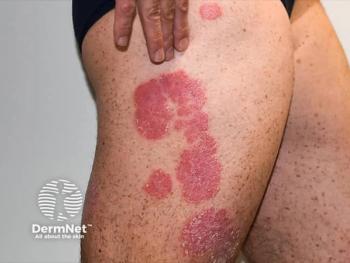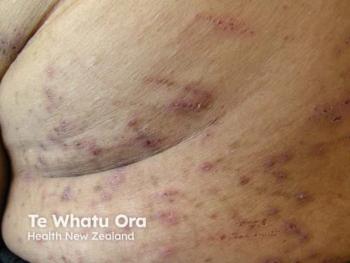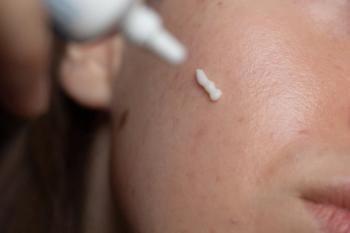
How Does Psoriasis Influence Sun Tanning Addiction?
Key Takeaways
- Excessive sun exposure in psoriasis patients is more common in younger individuals, often starting before age 20, with a lower incidence of photo-induced skin cancer.
- Younger, female patients with normal weight and higher education levels are at higher risk for excessive sun exposure.
Younger patients with moderate to severe psoriasis exhibit risky sun exposure behaviors, raising concerns about tanning addiction and skin cancer risks.
A new analysis has evaluated the sun exposure and tanning behaviors of patients with moderate to severe psoriasis.1 This data, taken from the French PsoBioTeq cohort, demonstrated higher levels of excessive sun exposure in younger patients with psoriasis.
Background
Phototherapy and sun exposure have been proven beneficial for psoriasis, although the risk of skin cancer is increased. Investigators hypothesized that this recommended sun treatment could be associated with excessive sun exposure or tanning addiction. Behavioral addiction to tanning is “a process whereby a behavior, that can function both to produce pleasure and to provide escape from internal discomfort, is employed in a pattern characterized by recurrent failure to control the behavior (powerlessness) and continuation of the behavior despite significant negative consequences.”2
Methods
The cross-sectional ancillary study took baseline data from 3705 participants in the PsoBioTeq cohort between July 2012 and April 2022. The prospective multicenter registry includes patients in France with moderate to severe psoriasis. The mean age was 47.4 years, and approximately 40% of participants were female. Patients entered the registry after beginning systemic or biologic treatment. Researchers extracted additional data on sociodemographic data, Fitzpatrick skin phototype, body mass index, smoking behaviors, comorbidities, psoriasis treatment history, and number of photo-induced lesions.
Results
About 17% reported excessive sun exposure by stating they tried to expose themselves to the sun as often as possible. These behaviors were displayed before the age of 20 in 59% of these patients. Patients were less likely to stay in the shade and use other protective sunscreen measures. Sunscreen was less frequently reapplied, particularly while sunbathing, and tanning beds were more likely to be used as well. However, this group had a lower number of participants with a history of photo-induced skin cancer (1.1% vs. 3.4%, p = 0.002).
A multivariate analysis showed that younger (OR 0.97, 95% CI [0.96; 0.97]) female (OR 1.52, 95% CI [1.20; 1.93]) patients with a normal weight (OR 0.57, 95% CI [0.42; 0.77]) had a higher risk of spending too much time in the sun (p < 0.001). These patients were also more likely to belong to the lower socioeconomic group with a higher level of education. The mean age of disease onset was 24.9 years, versus 31.5 years in the other group. Nearly 75% of patients with excessive sun exposure had Fitzpatrick skin types between III and IV (OR 1.80, 95% CI [1.36; 2.38]).
Those in this cohort also had a higher average DLQI score (p = 0.009) but no difference in PASI and PGA scores. The more likely previous treatments were phototherapy and cyclosporine(OR 1.53, 95% CI [1.19; 1.96]). Compared to the non-sun-exposed group, patients were less likely to be treated with methotrexate, anti-interleukin 12/23, and anti-interleukin 17 agents. Those who were previously treated with ustekinumab had a lower risk of being overexposed to the sun. Comorbidities, including dyslipidemia, hypertension, and diabetes, were less frequent in the group with excessive sun exposure.
The study does have some limitations, including the self-reported results, the cross-sectional design, and the potential for selection bias. To confirm the findings of this analysis, further studies must include control groups. These can be via general populations, patients with other skin diseases not related to sun exposure, or participants with mild psoriasis that does not necessitate phototherapy.
Conclusion
As tanning addiction frequently begins in adolescence, it is vital for clinicians and families to promote healthy sun prevention methods and limit the use of indoor tanning equipment. This is especially significant for patients with moderate to severe psoriasis.
“A greater understanding of this link is important for improving patient care by raising awareness and decreasing the potential for ultraviolet dependence and the associated risk of photo-induced skin cancers,” the authors concluded.
References
1. Mahé, E., Curmin, R., Paul, C., et al. (2025), Sun Exposure Behaviors of Patients With Moderate-to-Severe Psoriasis: Results From the French PSOBIOTEQ Cohort. JEADV Clinical Practice.
2. Goodman A. Addiction: definition and implications. Br J Addict. 1990;85(11):1403-1408. doi:10.1111/j.1360-0443.1990.tb01620.x
Newsletter
Like what you’re reading? Subscribe to Dermatology Times for weekly updates on therapies, innovations, and real-world practice tips.


















